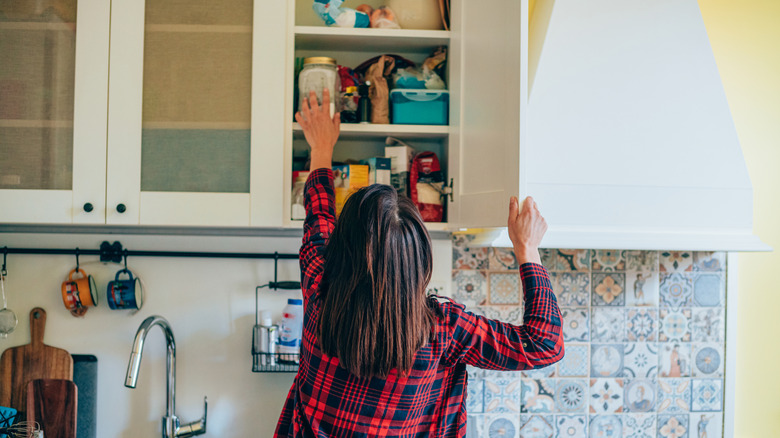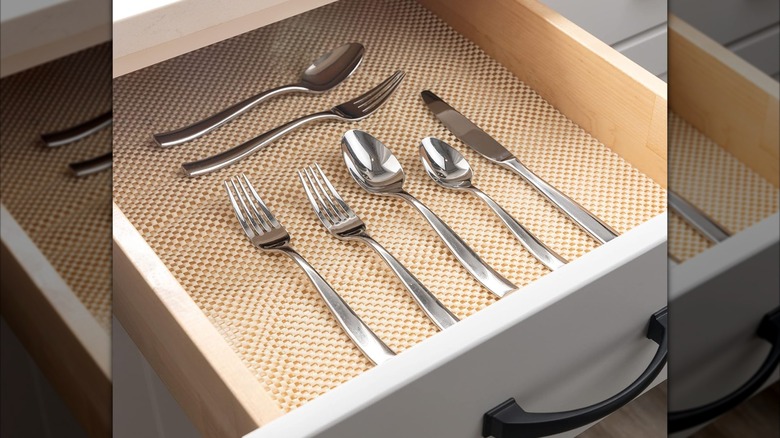Key Differences Between Shelf Liners And Contact Paper For Your Cabinets
The surfaces inside cabinets might not seem like a priority when it comes to attractive and perfectly organized kitchens. They are, after all, outside of anyone's normal view. That is until you notice scratches, spills, or scuff marks from heavy pots and pantry staples. These should be a reminder that your shelves work just as hard as the rest of your kitchen, and protecting them should be part of your routine.
It's easy to prevent these issues by using either shelf liners or contact paper. These two products might seem interchangeable at first glance since they both protect your surfaces from scratches, spills, and scuffs. But they're designed differently and choosing the wrong one could mean peeling adhesive, shifting liners, or worse, damage to your cabinet.
Shelf liners are non-adhesive or lightly adhesive materials that are reusable and easier to use, while contact paper is a self-adhesive vinyl sheet that has more space for customization. Each one has its strengths and weaknesses, so the choice ultimately depends on understanding their difference. Doing this will allow you to better protect your shelves, keep them looking neat, and avoid unnecessary headaches!
Simple and practical shelf liners
Shelf liners –- usually made of rubber or plastic –- are all about practicality in protecting your cabinet and drawers. They are easy to replace once past their time preventing damage on your surface. Most shelf liners are also non-adhesive so using them means just simply cutting them to size, inserting them, and adjusting as needed. This kind of flexibility is a huge plus for those who prefer low-maintenance solutions.
Shelf liners are no-fuss options too because of how reusable they are. This is particularly if you are just renting, frequently rearranging cabinets, or just prefer easy cleanup. They are also stable as their grippy textures help keep dishes, jars, or other items from sliding around. Choose a grippy or non-slip material if your shelves see a lot of activity. A thicker liner will help prevent sagging or uneven coverage if you're working with wire shelves. Cleaning up is simple too. Just wipe the liner with a damp cloth or remove it entirely for a quick rinse.
If aesthetics are high on your priority list, shelf liners might not be the most exciting option. They come in a variety of colors and patterns, but these are still limited. Since most are not adhesive, shelf liners can sometimes shift or bunch up especially on slippery surfaces. Just remember to measure your shelves carefully and cut the liner to fit snugly to prevent this from happening. You can also improve it by using double-sided tape if necessary.
Decorative and customizable contact paper
Contact paper is not just useful but can be decorative too. It offers a variety of design options that suit your style or your space's aesthetic. So this might be the option for you if you're looking to upgrade your cabinets beyond solid colors, like using faux marble contact paper from Rabitgoo or COSNIGHT's sleek woodgrain pattern contact paper. This adhesive vinyl sticks also directly to your shelf surfaces. Its adhesive backing gives contact paper an edge when it comes to staying firmly in place so it won't shift or move even with frequent use. Applying contact paper, however, takes a bit more effort than laying down a shelf liner.
Contact paper's adhesive backing, however, makes removal tricky and messy especially if it's been in place for a while. This makes using it less ideal for renters or anyone who likes to redecorate frequently. If applied poorly, you might end up with air bubbles or creases, which can be frustrating to fix. It is also generally not reusable. This means that you will always need a new sheet for replacement.
To get the best results when using contact paper, make sure that your shelves are thoroughly clean and dry so the adhesive sticks properly. You also need to work slowly in applying it to prevent wrinkles and use a ruler or any straight tool to smooth out any air bubbles as you go. Take your time trimming the edges carefully to ensure a precise and seamless finish. With the right product, you can achieve a polished look that keeps your shelves in top condition and your kitchen running smoothly!

